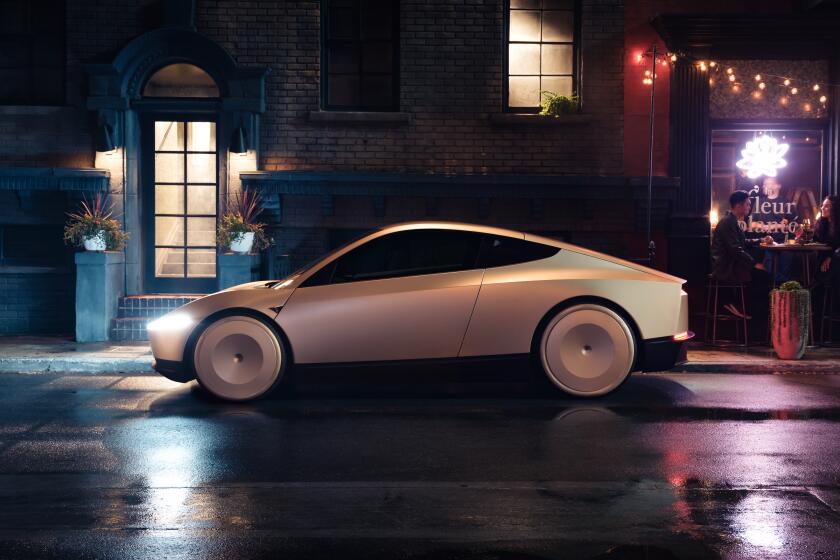Are Blimp Ads Just Hot Air? : As More Firms Use Flying Billboards, Critics Ask if High Costs Are Worth It
The familiar blimp with the Met Life logo was supposed to hover over tonight’s All-Star Game, but the company pulled out at the eleventh hour.
The decision had nothing to do with media frenzy following a Pizza Hut blimp that crashed last week onto the roof of a Manhattan apartment building. Far from it. With several other rival blimps snatching up airport space ahead of it, Metropolitan Life Insurance simply couldn’t find an available spot to park its blimp.
Three blimps--all vying for TV coverage--will float above Baltimore’s Camden Yards toting logos for Goodyear, Budweiser and the Family Channel. A record six commercial blimps cast their oblong shadows over this year’s Super Bowl. Pizza Hut’s accident notwithstanding, a growing number of marketers are convinced that commercial blimps make for dandy marketing tools. In fact, since last week’s accident, only Pizza Hut has grounded its blimp.
But are blimps effective marketing tools? They can cost up to $15 million to build and several million dollars a year to operate.
At least one marketing expert insists blimps are losers. “All a blimp does is make people look up,” said John Philip Jones, communications professor at Syracuse University. “If 20 million people see a product’s name on a blimp--but there is no attempt made to persuade them to do anything--it’s a big waste of money.”
Certainly, Pizza Hut didn’t think so. Its blimp was in the middle of a 19-city tour to promote its new “Bigfoot” pizza when the 165-foot-long blimp ran aground. Executives briefly considered locating another blimp to complete the tour, “but go try to find a spare blimp,” said Rob Doughty, marketing vice president.
*
For blimps, even more important than attracting spectators is attracting TV cameras. When the Goodyear blimp flew above the Orange Bowl on New Year’s Day this year, it was seen on camera for 27 seconds and received four verbal mentions. That alone was worth an estimated $335,000 in equivalent paid commercial TV time, estimates the Ann Arbor, Mich.-based research firm Joyce Julius & Associates.
For nearly 50 years, the Goodyear blimps were alone in the skies. Then along came Fuji. And the two have since been joined by Budweiser, Met Life, MCI, Blockbuster Video, Sea World, Gulf Oil, Virgin Atlantic Airways and even cable TV’s Family Channel. Several advertisers have also touted blimp ads in Europe, including Kraft Foods, Coca-Cola and Reebok.
Although the technology that keeps the helium-filled blimps afloat hasn’t changed much, the technology behind the ads plastered onto the blimps has gone very high-tech. Some now have fiber-optic signs that flash a dazzling array of images. And blimps operated by Virgin Airships are veritable floating billboards that actually light up from the inside--much like hot-air balloons--to illuminate the entire blimp.
But executives at Goodyear, which has been flying its blimps for 70 years, mostly smile at the competition. That’s because one recent study found that no matter whose name is on a blimp, people often associate it with Goodyear.
Two years ago, Performance Research, a Newport, R.I., ad research firm, polled TV viewers just after the U.S. Open tennis tournament had appeared on TV. Those who saw the event were asked which blimp was shown flying over the tournament. Only 46% correctly remembered that it was the Fuji blimp. About 26% thought it was the Goodyear blimp. And 27% had no idea.
Several years ago, when Goodyear was facing financial difficulties, the tire maker almost junked its fleet of blimps. After all, its three blimps together cost more than $10 million to operate annually.
But with 70 years of equity in the blimps, the company instead decided to update them. Goodyear spent more than $15 million to build its newest high-tech blimp, whose night messages and animation are created on sophisticated computers. It also repainted the blimps from drab gray to a bright blue and gold.
*
Was it worth all that effort? Well, earlier this year, Goodyear sponsored a “Blimp Days” sale in Vancouver, British Columbia. The tire sale was supported not just by newspaper ads, but by the blimp floating over the city for nearly two weeks. During that period, sales shot up 400%, said Mickey Wittman, manager of the airship program at Goodyear.
Blimps don’t just boost sales. Sometimes they also boost UFO sightings. Virgin Lightships, for example, which leases its blimps to both Sea World and Blockbuster Video, recently flew a Blockbuster blimp one evening from Manchester, England, to London. During that relatively short journey, police received nearly 2,500 phone calls from people who were baffled by the aircraft, said Bruce Renny, director of marketing for Orlando-based Virgin Lightships.
Indeed, there are “blimp groupies” who will follow the Family Channel’s blimp just about anywhere, said Eileen R. Carpenter, events director. “When the blimp’s parked at the airport, we’ll see cars lined down the road,” she said. “People sit on the hoods of their cars for hours just watching it.”
Meanwhile, Pizza Hut executives figure that their New York blimp crash wasn’t a complete disaster. “It may have helped to heighten brand awareness,” offered Doughty. With no pedestrians hurt--and the pilot and co-pilot escaping with minor injuries--Pizza Hut said the numerous news reports of its blimp crash may have actually been a promotional plus.
But not everyone buys that logic. “Next time I see a blimp, I won’t order a pizza,” joked Greenwich, Conn.-based corporate identity whiz Al Reis, “I’ll run for cover.”
Briefly . .
Home Depot, which parted ways with Century City-based Admarketing, has handed the creative broadcast portion of its $40-million account to the Dallas-based Richards Group and media planning portion to Western International Media. . . . Two local agencies, Kresser/Craig and Stein Robaire Helm, have made the final cut for the $40-million account for Kia Motors of North America. . . . Adweek reports that Chiat/Day and Stein Robaire Helm were among the 50 ad agencies invited to make presentations for IBM’s $30-million personal computer account. . . . The ad agency DMB&B;/Los Angeles has picked up the $2.5-million account for Lawman Jeans. . . . NBC this fall will launch an interactive service for advertisers that will feature toll-free numbers on the screen that viewers can phone for more information about products.
More to Read
Inside the business of entertainment
The Wide Shot brings you news, analysis and insights on everything from streaming wars to production — and what it all means for the future.
You may occasionally receive promotional content from the Los Angeles Times.










